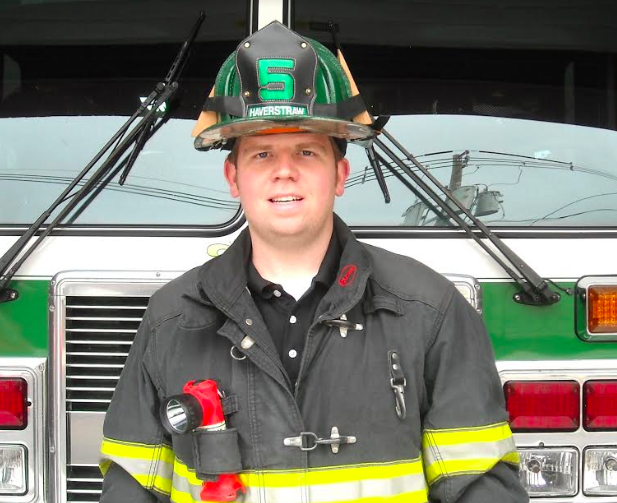 BY BARRY WARNER
BY BARRY WARNER
Our Unsung Hero this week is Charles Prevot, volunteer captain and interior firefighter of the Lady Warren Hose Company #5, fire training instructor and chairman of the Rockland County Recruitment and Retention Committee.
“A fire engine, also known as a fire pumper, carries many feet of fire hose, nozzles, hose couplings and equipment. It also carries 500 gallons of water for a quick attack on a fire, which is critical to fire control until a dedicated water supply can be established from a fire hydrant,” Prevot told the Rockland County Times. “There are many types of structures in Haverstraw including garden apartments, three-story colonials, stores and the Harbors Complex containing condominiums and high rises. When responding to false alarms, we can use the incidents as drills to get the layout of the buildings. During a fire call, the hose is hooked up to a hydrant. Then we check with the chief where to go and determine the best access. The nozzle team checks that there’s no hang-up of the hose, supports the weight of the hose and enters the door of the structure to extinguish the seat of the fire. At this time, other fire companies look for victims. The plan is to open walls, ceilings and partitions to prevent fire extension, plus save living space and interior stairs.”
“I am the Chairman of the Recruitment and Retention Committee—my objective is to attract new members by getting out to the high schools and colleges, producing ads for the local movie screens and Channel 12 and attracting newcomers during Fire Prevention Week in October,” Prevot continued. “I reach out to the 26 fire companies in Rockland County to find out what’s working and not working regarding their own recruitment and retention efforts.”
One of the most important functions of the engine company officer is to ensure the training and readiness of its personnel. There are locations to practice including parking lots, playgrounds, schools, parking garages and vacant buildings. Training procedures include:
1 Removing the hose from the apparatus.
2 Removing the right amount of hose or lead length.
3 Carrying the hose effectively on the shoulder or arm.
4 Flaking or stacking the hose line.
5 Dealing with obstacles.
6 Staging enough hose at the entrance point of a structure.
7 Flaking the nozzle and coupling for the lead line advance.
8 Knowing when to charge the line with water.
9 Donning personnel protective equipment (PPE)-mask, hood, helmet and gloves.
Stretching the hose to a fire is a team effort that requires coordination. For the hose line to be effective, it must be mobile, which means the crew must spread out the lengths they need to advance. After the section of hose is advanced and the nozzleman is ready to open the nozzle, the backup members must move back into position to assist the nozzleman. One member checks that all of the hose has been cleared from the hosebed because extra hose can kink where it’s folded causing a water restriction that could affect the fire attack. The pump operator ensures any hose remaining in the bed is cleared before charging it with water. The first hose line should go between the fire and the victims. Usually the front door is the best route to achieve this position, plus the hose line should protect the interior stairs from fire extension. Flow is the volume of water delivered through the hose lines to the burning material by means of the force of the fire pump. The horizontal and vertical reach of the fire stream expands as the pressure is increased, within the range of the nozzle in use. Heat, wind, building partitions and the angle of the stream all have an impact on the stream’s reach. Nozzle pressure is the optimum pressure needed at the end of the hose line for the nozzle to produce an effective nozzle stream.
Fire Coordinator Peter Byrne wrote in the Rockland County Volunteer Firemens’ Association October 2017 issue of the ‘Trumpet’ newsletter, “Over the last three years we have noticed a significant drop in the number of recruits graduating as interior firefighters. This trend started after the very successful recruitment effort ran out of federal funding that was secured by the Recruitment and Retention Committee through a Safer Grant. Some departments are doing well, while others are struggling. We must reverse this trend over the next year or so, or some of our departments will be in serious condition. I encourage every department to make recruitment of new members and retention a top priority. The Recruitment and Retention Committee Chairman Charles Prevot leads a group of creative leaders who are working on new ideas.”
“I started my involvement with the fire service in 2006 with the Congers Fire Department and have been with the Lady Warren Hose Company #5 since 2008, serving as Captain from 2013 to 2017,” Prevot concluded. “My father was a New City firefighter and I grew up around the New City firehouse. In addition, my grandfather was a firefighter for the FDNY. I’ve built relationships with fellow firefighters and have networked as a business owner. We have a tight-knit group and all the guys know each other. We have pride knowing that we have an aggressive firefighting team to help our neighbors in distress. I love volunteering and continue to learn as I challenge myself.”
For information about volunteering for the Haverstraw Fire Department, call 845-429-0300.

You must be logged in to post a comment Login